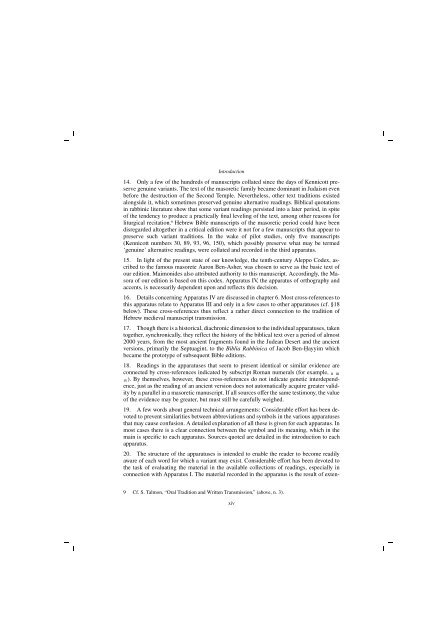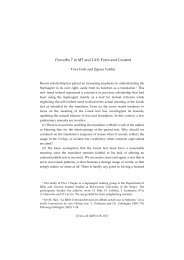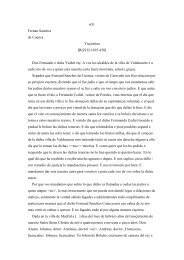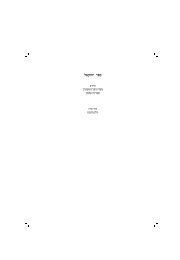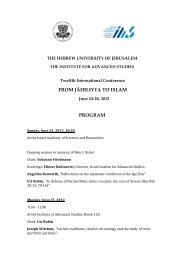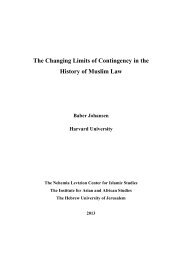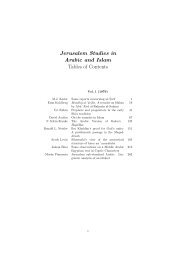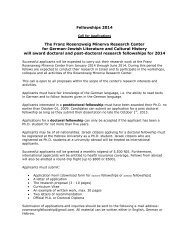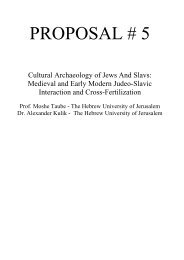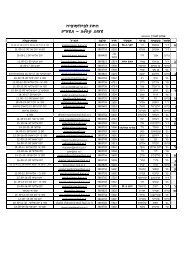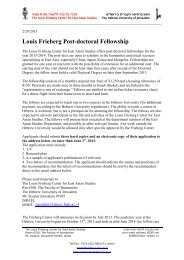THE BOOK OF EZEKIEL Moshe H. Goshen-Gottstein Shemaryahu ...
THE BOOK OF EZEKIEL Moshe H. Goshen-Gottstein Shemaryahu ...
THE BOOK OF EZEKIEL Moshe H. Goshen-Gottstein Shemaryahu ...
You also want an ePaper? Increase the reach of your titles
YUMPU automatically turns print PDFs into web optimized ePapers that Google loves.
Introduction<br />
14. Only a few of the hundreds of manuscripts collated since the days of Kennicott preserve<br />
genuine variants. The text of the masoretic family became dominant in Judaism even<br />
before the destruction of the Second Temple. Nevertheless, other text traditions existed<br />
alongside it, which sometimes preserved genuine alternative readings. Biblical quotations<br />
in rabbinic literature show that some variant readings persisted into a later period, in spite<br />
of the tendency to produce a practically final leveling of the text, among other reasons for<br />
liturgical recitation. 9 Hebrew Bible manuscripts of the masoretic period could have been<br />
disregarded altogether in a critical edition were it not for a few manuscripts that appear to<br />
preserve such variant traditions. In the wake of pilot studies, only five manuscripts<br />
(Kennicott numbers 30, 89, 93, 96, 150), which possibly preserve what may be termed<br />
‘genuine’ alternative readings, were collated and recorded in the third apparatus.<br />
15. In light of the present state of our knowledge, the tenth-century Aleppo Codex, ascribed<br />
to the famous masorete Aaron Ben-Asher, was chosen to serve as the basic text of<br />
our edition. Maimonides also attributed authority to this manuscript. Accordingly, the Masora<br />
of our edition is based on this codex. Apparatus IV, the apparatus of orthography and<br />
accents, is necessarily dependent upon and reflects this decision.<br />
16. Details concerning Apparatus IV are discussed in chapter 6. Most cross-references to<br />
this apparatus relate to Apparatus III and only in a few cases to other apparatuses (cf. §18<br />
below). These cross-references thus reflect a rather direct connection to the tradition of<br />
Hebrew medieval manuscript transmission.<br />
17. Though there is a historical, diachronic dimension to the individual apparatuses, taken<br />
together, synchronically, they reflect the history of the biblical text over a period of almost<br />
2000 years, from the most ancient fragments found in the Judean Desert and the ancient<br />
versions, primarily the Septuagint, to the Biblia Rabbinica of Jacob Ben-Hayyim . which<br />
became the prototype of subsequent Bible editions.<br />
18. Readings in the apparatuses that seem to present identical or similar evidence are<br />
connected by cross-references indicated by subscript Roman numerals (for example, r s<br />
t). By themselves, however, these cross-references do not indicate genetic interdependence,<br />
just as the reading of an ancient version does not automatically acquire greater validity<br />
by a parallel in a masoretic manuscript. If all sources offer the same testimony, the value<br />
of the evidence may be greater, but must still be carefully weighed.<br />
19. A few words about general technical arrangements: Considerable effort has been devoted<br />
to prevent similarities between abbreviations and symbols in the various apparatuses<br />
that may cause confusion. A detailed explanation of all these is given for each apparatus. In<br />
most cases there is a clear connection between the symbol and its meaning, which in the<br />
main is specific to each apparatus. Sources quoted are detailed in the introduction to each<br />
apparatus.<br />
20. The structure of the apparatuses is intended to enable the reader to become readily<br />
aware of each word for which a variant may exist. Considerable effort has been devoted to<br />
the task of evaluating the material in the available collections of readings, especially in<br />
connection with Apparatus I. The material recorded in the apparatus is the result of exten-<br />
9 Cf. S. Talmon, “Oral Tradition and Written Transmission,” (above, n. 3).<br />
xiv


